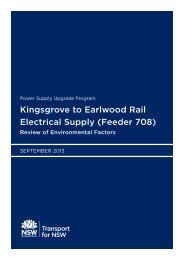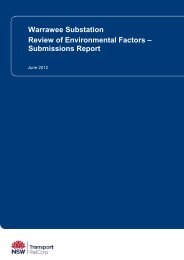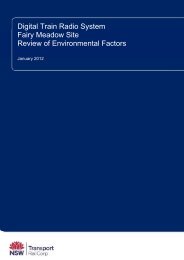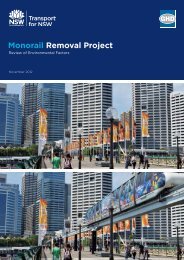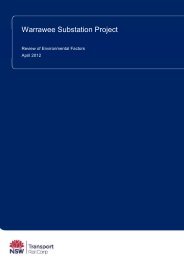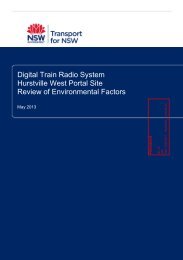Review of Environmental Factors - Transport for NSW - NSW ...
Review of Environmental Factors - Transport for NSW - NSW ...
Review of Environmental Factors - Transport for NSW - NSW ...
You also want an ePaper? Increase the reach of your titles
YUMPU automatically turns print PDFs into web optimized ePapers that Google loves.
• The network is both inside and outside the rail corridor.• GRN would require a substantial upgrade, including new base stations, to ensure 100%network coverage <strong>of</strong> the rail corridor.• The cost <strong>of</strong> this upgrade is comparable to the development <strong>of</strong> an entire new network.The radio communications marketplace responded with three systems: APCO-25, TETRA andGSM-R.APCO-25 is a proven standard <strong>for</strong> emergency services but was rejected <strong>for</strong> the reasons listedbelow.• It has no proven history <strong>of</strong> usage in a rail environment.• It does not support a functional addressing system that maps train run numbers to mobilesubscribers’ numbers, which is a key requirement.• It does not meet the interoperability requirements.• It relies on a dispatch terminal <strong>for</strong> functionality, which does not meet RailCorp’s reliabilityrequirements.• It is not scalable in regard to the future growth <strong>of</strong> the rail network.TETRA is also a proven emergency services communications system and is deployed in anumber metropolitan rail networks. However, it was rejected <strong>for</strong> the reasons listed below.• This application is confined primarily to underground metro networks that are notcomparable to RailCorp’s network.• It relies on a dispatch terminal <strong>for</strong> functionality, which does not meet the RailCorp reliabilityrequirements.• It does not meet the interoperability requirements.• There is no commercialised Automatic Train Protection (ATP) solution available.GSM-R was deemed the plat<strong>for</strong>m most suitable <strong>for</strong> RailCorp’s train network and systemrequirements <strong>for</strong> the reasons listed below.• It is the only rail-specific communications standard and has the highest levels <strong>of</strong> safety andreliability in its design.• It is an open standard with a large number <strong>of</strong> equipment suppliers.• It achieved a higher level <strong>of</strong> compliance with the RailCorp functional requirements whencompared to the other systems.• It is deployed by major rail operators in Europe and Asia, some with networks comparablein size and complexity to RailCorp’s network.Page 26 <strong>of</strong> 64



